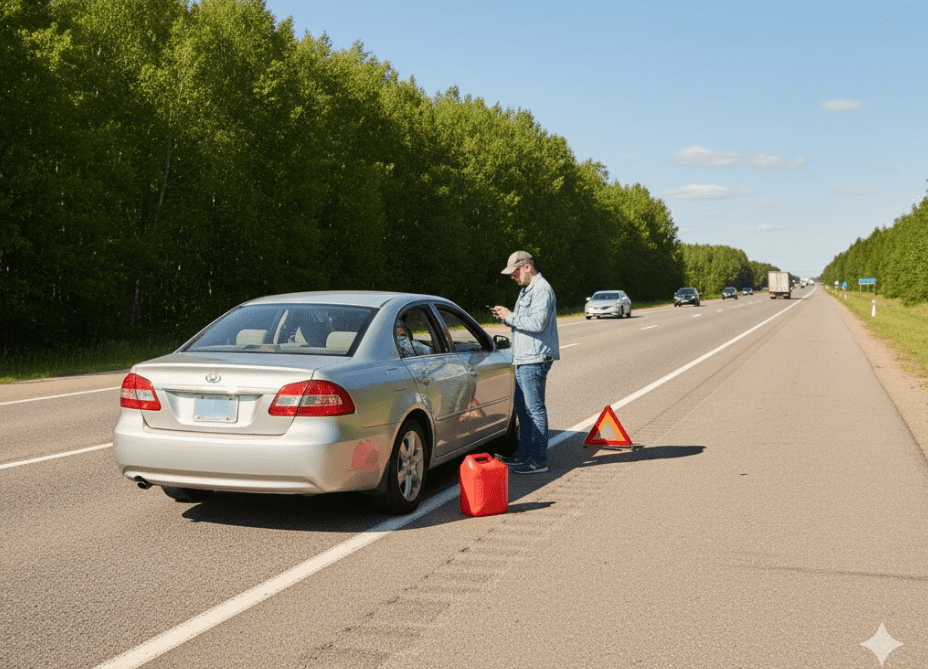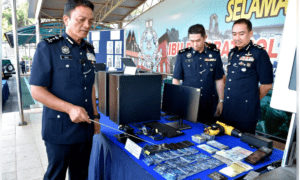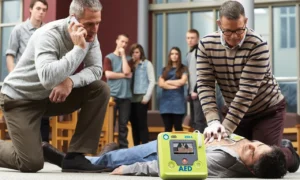Running out of gas while driving is one of those situations every driver dreads. It often happens at the most inconvenient times, on a highway, during a late-night drive, or far from the nearest fuel station. While modern cars have fuel indicators and alerts, life can get busy, and sometimes you simply forget to refuel.
In 2019, during just January to April, AAA responded to 205,549 “out of gas” calls.
The good news is that running out of gas doesn’t have to spell disaster. With a calm approach and the right knowledge, you can handle the situation safely and efficiently. Here are ten practical tips to follow if you ever find yourself stranded without fuel.
1. Stay Calm and Assess the Situation
The first rule is not to panic. Take a deep breath and assess your surroundings. Check your dashboard to confirm you’re truly out of gas and not dealing with another issue like a dead battery or mechanical fault. Staying calm helps you think clearly about your next steps. If you’re away from help and suspect a more serious problem with the vehicle, contact a roadside assistance service immediately for professional support and safety. Staying calm and methodical helps you make the right decision without putting yourself at risk.
2. Safely Pull Over
As soon as you feel your car sputtering or losing power, signal and steer your vehicle to the side of the road. Ideally, aim for the shoulder, a rest stop, or a safe spot away from traffic. Turn on your hazard lights immediately to alert other drivers that your vehicle is immobile. If your car stalls in the middle of the road and you’re unable to pull over, you may carefully use the starter motor to move it to safety if it’s a manual car. Shift the car into first gear, engage the handbrake for control, then gently turn the ignition key while slowly releasing the clutch to let the car inch forward. Use this only in emergencies and for very short distances, as it can strain the starter motor and transmission. Always turn on your hazard lights and prioritize safety before attempting this. This method is not for every car, as some cars cannot move with a starter motor. So you may need to first enter neutral gear and release the hand brake and then drag the car to safety.
3. Keep Yourself Visible
Once parked, make sure you and your car are visible to others. Use hazard lights, reflective triangles, or flares if available. This is especially important at night or in poor weather conditions. Visibility reduces the risk of accidents and makes it easier for roadside assistance to locate you.
4. Avoid Leaving Your Car in Unsafe Areas
If you’re on a busy highway or an unfamiliar area, it’s safer to stay inside your vehicle with the doors locked until help arrives. Walking to find a gas station is risky unless you’re absolutely sure it’s close by and the area is safe for pedestrians.
5. Call for Roadside Gas Delivery
Roadside assistance services can deliver fuel directly to you. If you have a membership through your insurance provider, credit card, or a dedicated service app, this is often the fastest and safest option. Keep your membership details handy in your glovebox or phone for emergencies like this. Today, many reliable services offer on-demand fuel delivery within minutes, especially in larger cities like Philadelphia, Allentown, and Pittsburgh.
If you’re in or around Philadelphia and run out of gas, you can request professional roadside gas delivery through CruZen, a local app designed to provide fast, dependable assistance in Philly.
6. Use a Portable Gas Can
If it’s safe to do so and there’s a gas station nearby, you can walk and purchase a small amount of fuel in a portable gas can. Always ensure the container is designed for gasoline, and never attempt to carry fuel in makeshift containers. Once you’ve added enough to the tank, drive straight to the nearest station to fill up properly.
7. Conserve Battery Power
While waiting for assistance, avoid using your car’s electrical systems unnecessarily. Running the AC, radio, or lights (other than hazards) can drain the battery, leaving you with an additional problem when it’s time to restart the car.
8. Keep Emergency Supplies in Your Car
Running out of gas is easier to handle if you’re prepared. Keep a basic emergency kit in your trunk that includes items like a flashlight, portable phone charger, reflective vest, bottled water, and a first-aid kit. These supplies make waiting safer and more comfortable.
9. Learn to Prevent the Problem
The best way to handle running out of gas is to avoid it in the first place. Make it a habit to refuel once your tank reaches the quarter mark instead of waiting until the warning light comes on. On long trips, plan fuel stops ahead of time using apps that locate stations along your route.
10. Consider Roadside Subscription Plans
If you drive frequently, investing in a roadside assistance plan or car care subscription can save you stress in emergencies. These plans often include fuel delivery, towing, flat-tire repair, and jump-start services. With just one call or app request, you’ll have help on the way.
Final Thoughts
Running out of gas on the road is inconvenient, but it doesn’t have to become a crisis. By staying calm, pulling over safely, and knowing your options, whether it’s calling roadside assistance, walking with a gas can, or relying on an emergency plan, you can handle the situation with confidence.
More importantly, prevention is key. Refueling early, carrying emergency supplies, and investing in roadside support can ensure you’re never caught off guard.
The road will always bring surprises, but with preparation and smart decision-making, running out of gas can be just a small hiccup in your journey, not a major setback.





























